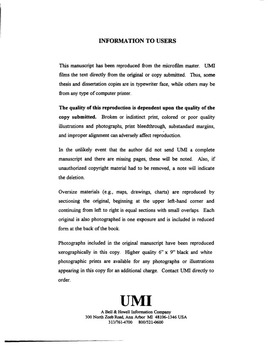| dc.contributor.advisor | Scamehorn, John F., | en_US |
| dc.contributor.author | Tabatabai, Ahmadali. | en_US |
| dc.date.accessioned | 2013-08-16T12:30:08Z | |
| dc.date.available | 2013-08-16T12:30:08Z | |
| dc.date.issued | 1998 | en_US |
| dc.identifier.uri | https://hdl.handle.net/11244/5680 | |
| dc.description.abstract | The results of this work were modeled using an ion-binding model based on a two-phase approximation theory to predict rejection of the hardness ions. The model is highly accurate in prediction of rejections at low concentrations of added salt. However, at higher salt concentrations the model deviates from experimental results. | en_US |
| dc.description.abstract | The experimental ultrafiltration results were scaled up for large scale applications. The PEUF process as a water softening technique was compared with lime softening and ion exchange. A cradle to grave scenario was developed to account for all costs associated with water softening. | en_US |
| dc.description.abstract | This investigation has demonstrated the effectiveness of polyelectrolyte-enhanced ultrafiltration (PEUF) as a viable technique for water softening. It is shown that PEUF is effective in the rejection of up to 99.7% of hardness ions from aqueous streams. It is further shown that in the presence of low concentrations of added salt, the rejection is still high. The effect of temperature is negligible on rejection of multivalent ions. However, an increase in temperature increases flux of solution across the ultrafiltration membrane. | en_US |
| dc.description.abstract | As flowrate increased, so did the cost of the PEUF process. Furthermore, an optimum percent of the feed recovered results in a minimum cost for PEUF process. At low recovery of the feed stream, PEUF cost is too high due to the small amount of product. At higher recovery, the retentate stream becomes too concentrated leading to increased concentration polarization and a higher cost of operation for the PEUF process. | en_US |
| dc.description.abstract | The PEUF process is nearly competitive with lime softening at low flow rates. In comparison with ion exchange for the removal of only multivalent ions, the PEUF process is not nearly as economically feasible. For a feed stream containing both multivalent ions as well as bacteria and viruses, PEUF becomes more competitive with ion exchange. (Abstract shortened by UMI.) | en_US |
| dc.description.abstract | Maximum rejection of multivalent ions using regenerated polyelectrolyte was always less than maximum rejection using fresh polyelectrolyte. | en_US |
| dc.description.abstract | Recovery of the polyelectrolyte was also investigated. Of the recovery processes considered, three provided the greatest promise: (1) addition of sodium carbonate to precipitate the bound multivalent ions, (2) addition of sodium chloride to replace the bound multivalent ions with sodium ions, and (3) addition of hydrochloric acid to replace the bound multivalent ions with hydrogen ions. The optimum recovery occurred when the least amount of an additive was used and the highest multivalent ion rejection was obtained using the regenerated polyelectrolyte. | en_US |
| dc.format.extent | xv, 147 leaves : | en_US |
| dc.subject | Engineering, Environmental. | en_US |
| dc.subject | Water Softening. | en_US |
| dc.subject | Polyelectrolytes. | en_US |
| dc.subject | Water Purification. | en_US |
| dc.subject | Ultrafiltration. | en_US |
| dc.subject | Engineering, Sanitary and Municipal. | en_US |
| dc.subject | Engineering, Chemical. | en_US |
| dc.title | Technical and economic feasibility study of polyelectrolyte-enhanced ultrafiltration (PEUF) for the removal of multivalent ions from water. | en_US |
| dc.type | Thesis | en_US |
| dc.thesis.degree | Ph.D. | en_US |
| dc.thesis.degreeDiscipline | School of Chemical, Biological and Materials Engineering | en_US |
| dc.note | Adviser: John F. Scamehorn. | en_US |
| dc.note | Source: Dissertation Abstracts International, Volume: 59-07, Section: B, page: 3589. | en_US |
| ou.identifier | (UMI)AAI9839814 | en_US |
| ou.group | College of Engineering::School of Chemical, Biological and Materials Engineering | |
